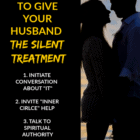Silent Treatment In Marriage: Is It A Silent Divorce?

Table of Contents
Understanding the Dynamics of the Silent Treatment in Marriage
What is the Silent Treatment?
The silent treatment in marriage is a deliberate refusal to communicate with one's partner. It's more than just needing some quiet time or space for reflection; it's a manipulative tactic used to punish, control, or avoid conflict. Unlike healthy periods of solitude, the silent treatment is characterized by an intentional withdrawal of verbal and often non-verbal communication, creating an atmosphere of tension and emotional distance. This creates a communication breakdown that damages the marital bond.
Why Couples Use the Silent Treatment
Several underlying reasons contribute to the use of the silent treatment in marital relationships:
- Feeling overwhelmed and needing space (but used manipulatively): While needing space can be a valid response to stress, using silence as a weapon is different. It becomes manipulative when it's used to control the partner.
- A way to punish or control the partner: The silent treatment is often a passive-aggressive way of expressing anger or resentment, aiming to make the partner feel guilty or anxious.
- A learned behavior from childhood: Individuals who witnessed similar communication patterns in their family of origin might unconsciously replicate these behaviors in their own relationships.
- Avoidance of difficult conversations: The silent treatment can be a way to avoid addressing underlying relationship problems and conflict. This avoidance only exacerbates the problem.
The Psychological Impact of the Silent Treatment
The silent treatment takes a significant toll on both partners. The receiving partner often experiences:
- Isolation and loneliness: The lack of communication creates a profound sense of isolation and disconnection.
- Anxiety and insecurity: The unpredictable nature of the silent treatment fuels anxiety and uncertainty about the relationship's future.
- Decreased self-esteem: Being ignored or shut out can severely damage one's self-worth and confidence.
- Resentment and anger: The silent treatment breeds resentment and anger in the receiving partner, escalating the cycle of conflict.
- Depression: The prolonged emotional distress caused by the silent treatment can lead to feelings of depression and hopelessness.
The Silent Treatment as a Form of Emotional Abuse
Recognizing Emotional Abuse
Emotional abuse involves behaviors that undermine a person's self-worth, sense of security, and emotional well-being. The silent treatment fits this definition because it's used to control and manipulate the other partner, creating a climate of fear and intimidation. Examples include ignoring phone calls and texts, refusing to engage in conversation, and giving the cold shoulder for extended periods. This subtle yet powerful form of abuse can be just as damaging as physical violence.
The Power Dynamics of Silent Treatment
The silent treatment often reflects an imbalance of power in the relationship. The partner who employs this tactic seeks to control the conversation and the emotional landscape of the relationship, leaving the other partner feeling powerless and vulnerable. It's a clear sign of relationship problems.
Long-Term Effects of Emotional Abuse
The long-term effects of the silent treatment on a relationship are severe. It creates:
- Increased distrust: The consistent use of the silent treatment erodes trust, making it difficult to feel safe and secure in the relationship.
- Communication barriers: The silent treatment reinforces unhealthy communication patterns, making it harder to communicate openly and honestly.
- Escalation of conflict: The silent treatment often escalates into more severe forms of conflict, including verbal abuse or physical violence.
- Negative impact on children: If children witness this form of emotional abuse, it can negatively impact their emotional development and well-being.
Is the Silent Treatment a Sign of Impending Divorce?
Erosion of Trust and Communication
Consistent use of the silent treatment fundamentally erodes the trust and communication that form the bedrock of a healthy marriage. When communication breaks down completely, it becomes difficult, if not impossible, to resolve conflicts, share emotions, or maintain intimacy. This is a critical sign of relationship problems that require immediate attention.
The Breakdown of Intimacy
The emotional distance created by the silent treatment directly impacts intimacy, both physical and emotional. A lack of communication fosters feelings of isolation and disconnection, making it challenging to feel close to one's partner. This emotional chasm can lead to a significant decline in sexual intimacy as well.
Seeking Help Before It's Too Late
Addressing the silent treatment is essential to preventing marital breakdown. If this pattern is present in your marriage, seeking professional help is crucial. Couples therapy can provide a safe space to explore underlying issues, learn healthy communication skills, and rebuild trust. Ignoring the problem risks a slow, painful "silent divorce."
Overcoming the Silent Treatment and Rebuilding Communication
Identifying the Root Causes
To overcome the silent treatment, it's crucial to identify the underlying issues fueling this behavior. This might involve exploring past traumas, addressing unresolved conflicts, or improving individual coping mechanisms for managing stress and anger.
Developing Healthy Communication Skills
Improving communication is paramount. Couples should learn:
- Active listening: Truly hearing and understanding your partner's perspective.
- Assertive communication: Expressing needs and feelings clearly and respectfully.
- Conflict resolution techniques: Developing strategies for resolving disagreements constructively.
Seeking Professional Guidance
A marriage counselor or therapist specializing in communication and conflict resolution can offer invaluable support and guidance. They can provide tools and techniques for improving communication, addressing underlying relationship issues, and breaking free from destructive patterns like the silent treatment.
Conclusion
The silent treatment in marriage is a serious issue with far-reaching consequences. It's a form of emotional abuse that erodes trust, damages communication, and can ultimately lead to marital breakdown or a "silent divorce." Don't let the silent treatment destroy your marriage. If you're experiencing this in your relationship, take action. Seek professional help, attend couples therapy, and commit to learning healthy communication skills. Addressing the silent treatment proactively can save your marriage and build a stronger, healthier relationship. Don't let silent treatment in your marriage become a silent divorce. Seek help today and begin rebuilding communication and trust.

Featured Posts
-
 Yankees 12 3 Win Frieds Debut And Offensive Explosion
Apr 28, 2025
Yankees 12 3 Win Frieds Debut And Offensive Explosion
Apr 28, 2025 -
 The Evolving Landscape Of Business Mapping Key Growth Areas
Apr 28, 2025
The Evolving Landscape Of Business Mapping Key Growth Areas
Apr 28, 2025 -
 Silent Treatment In Marriage Is It A Silent Divorce
Apr 28, 2025
Silent Treatment In Marriage Is It A Silent Divorce
Apr 28, 2025 -
 Virginia Giuffre Report Of Death Prompts Renewed Focus On Epstein Case
Apr 28, 2025
Virginia Giuffre Report Of Death Prompts Renewed Focus On Epstein Case
Apr 28, 2025 -
 Dwyane Wade Highlights Doris Burkes Insightful Thunder Timberwolves Breakdown
Apr 28, 2025
Dwyane Wade Highlights Doris Burkes Insightful Thunder Timberwolves Breakdown
Apr 28, 2025
